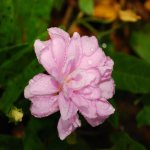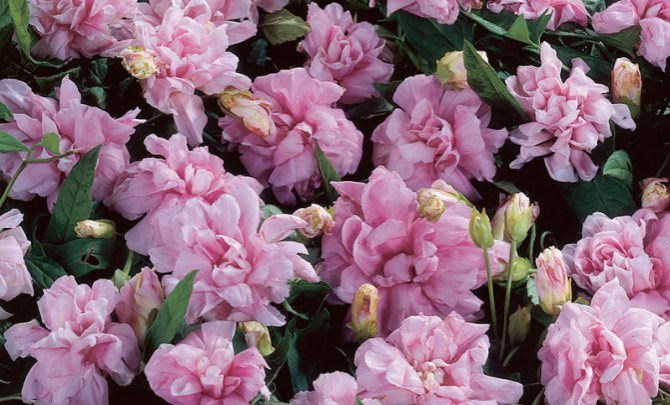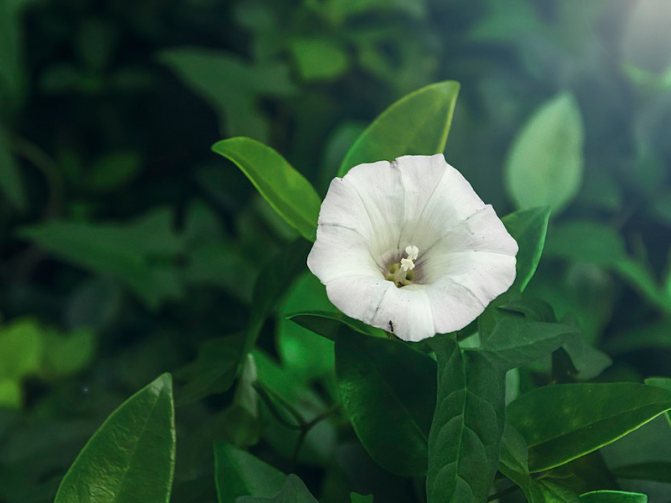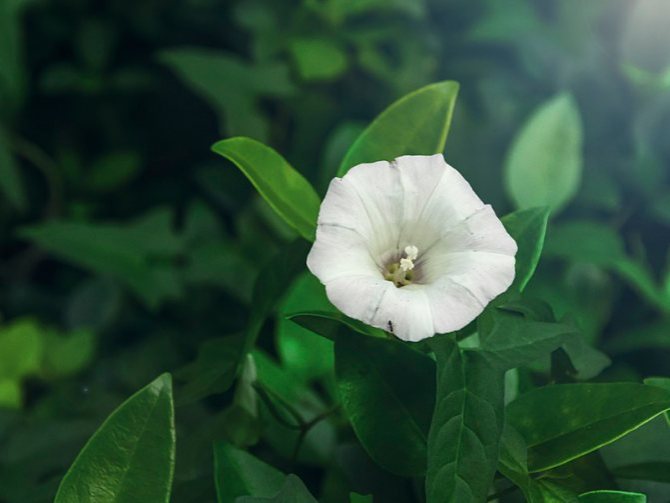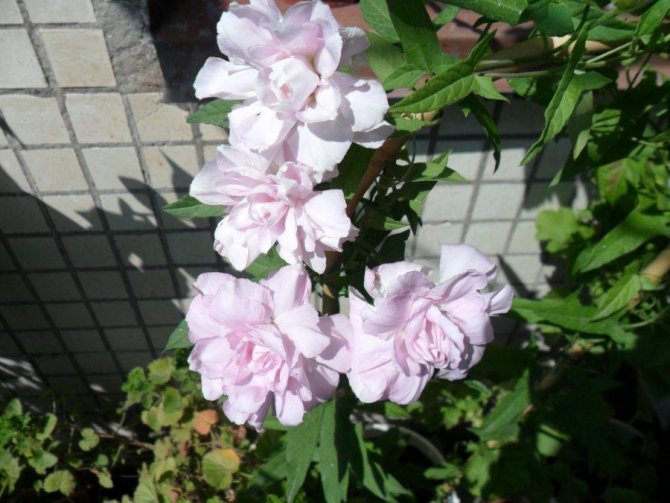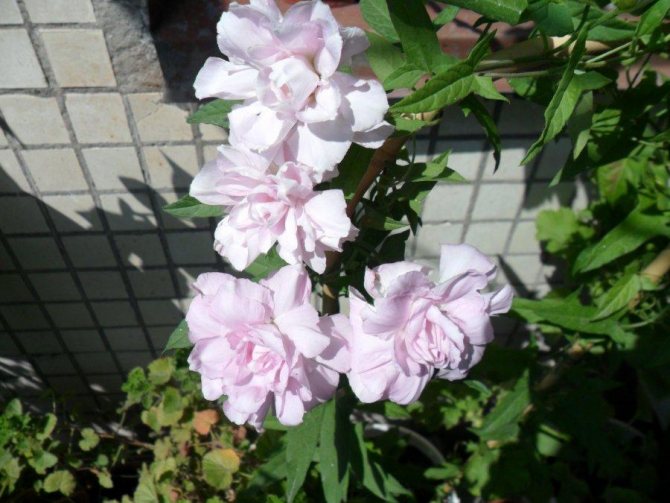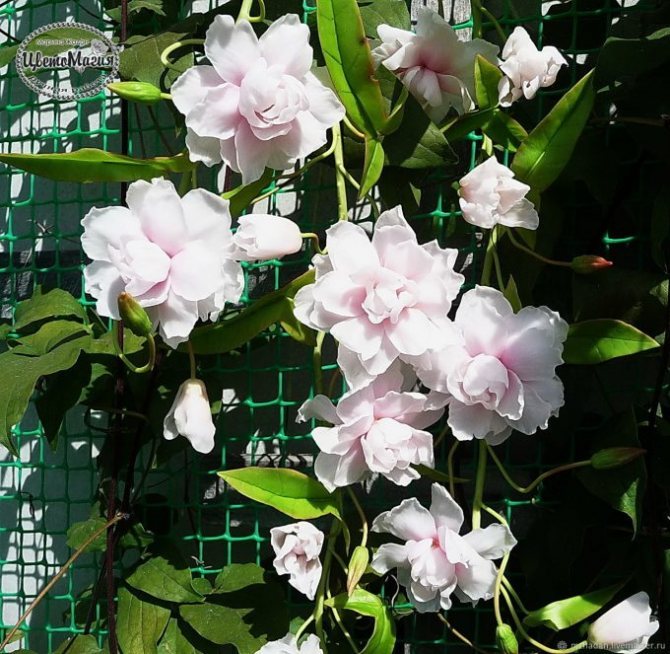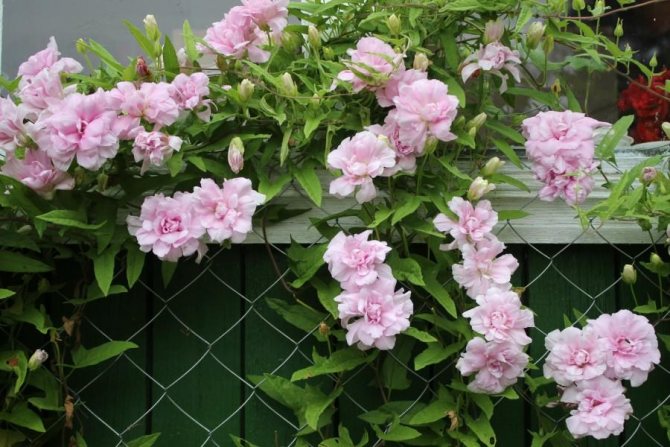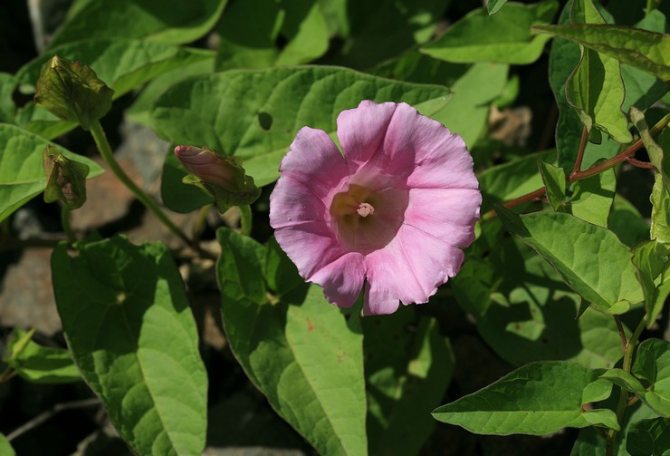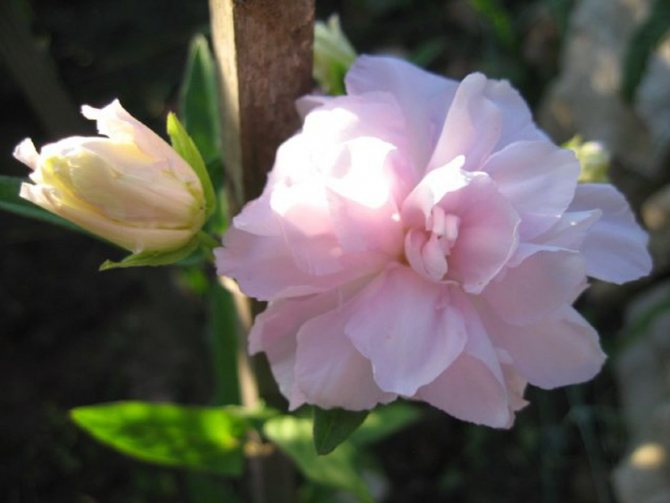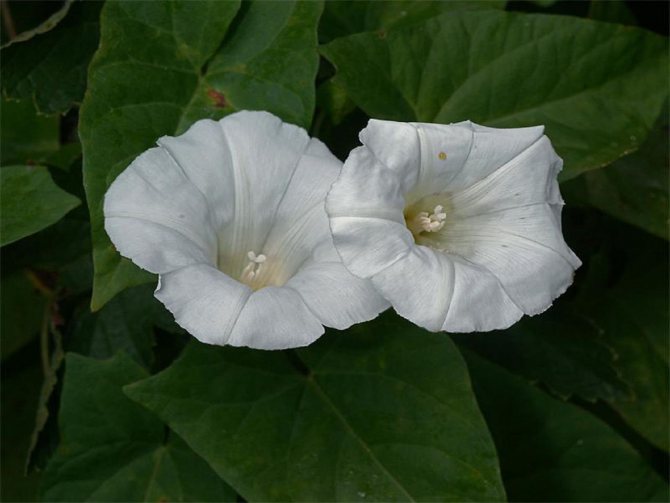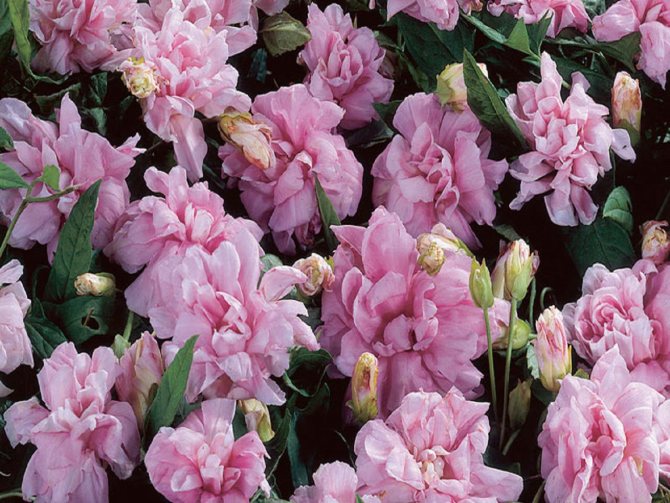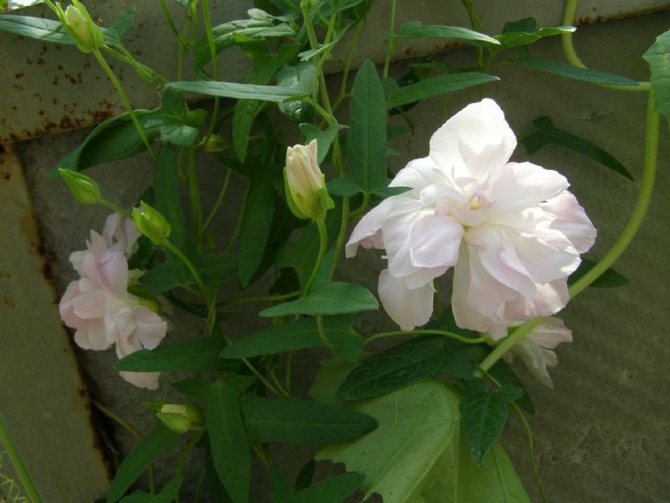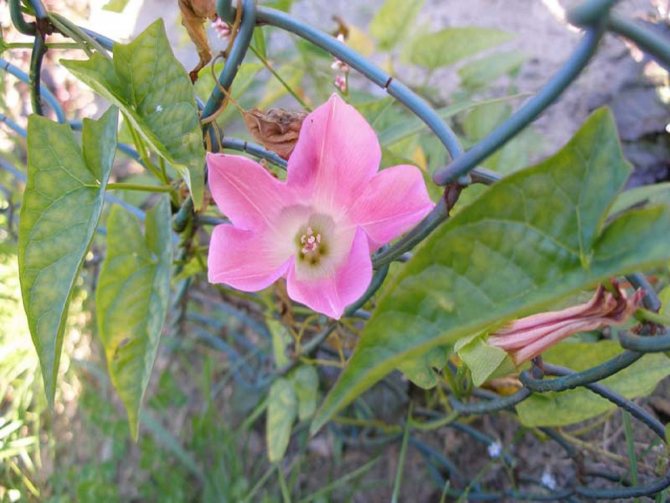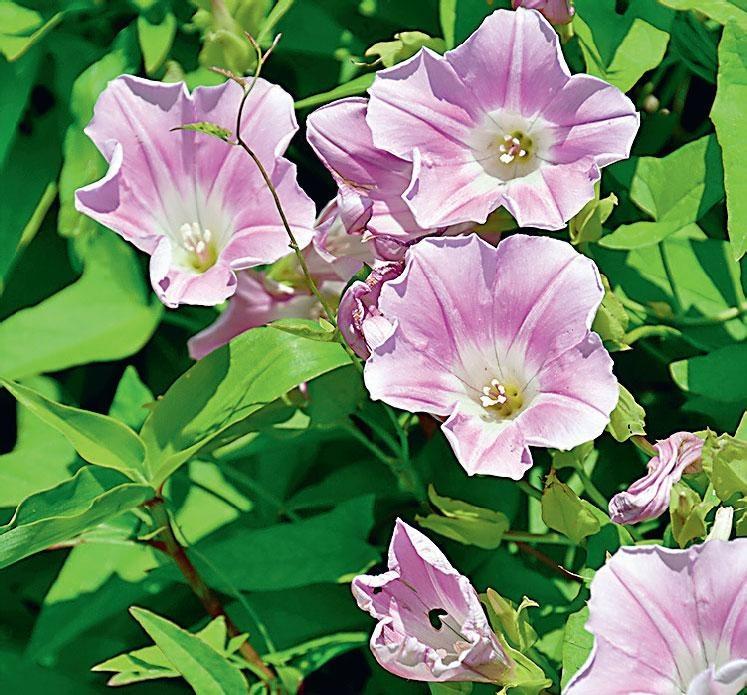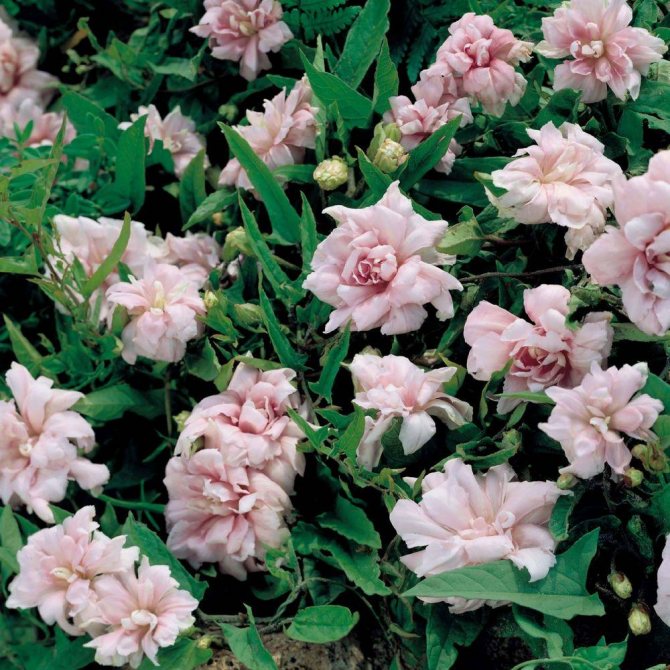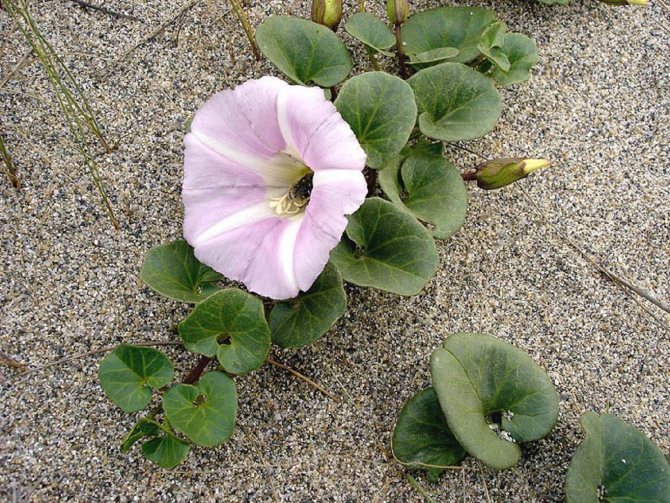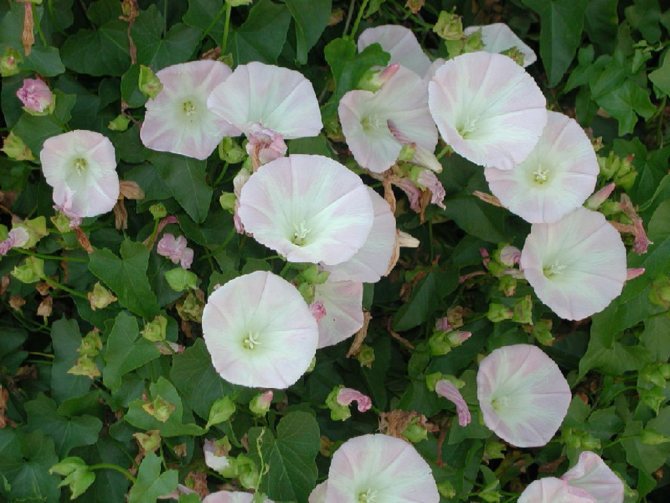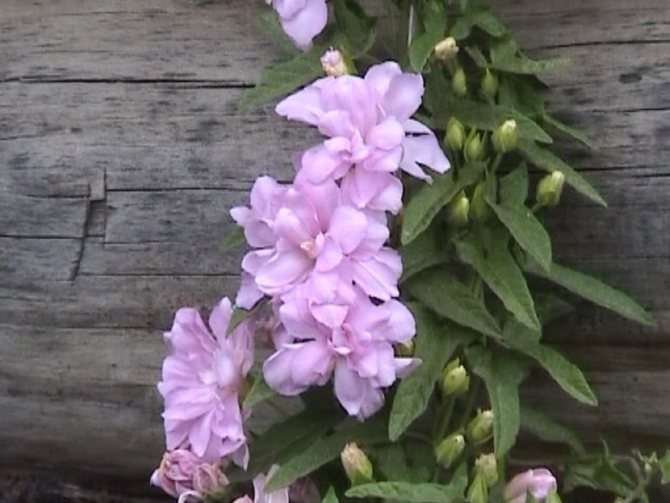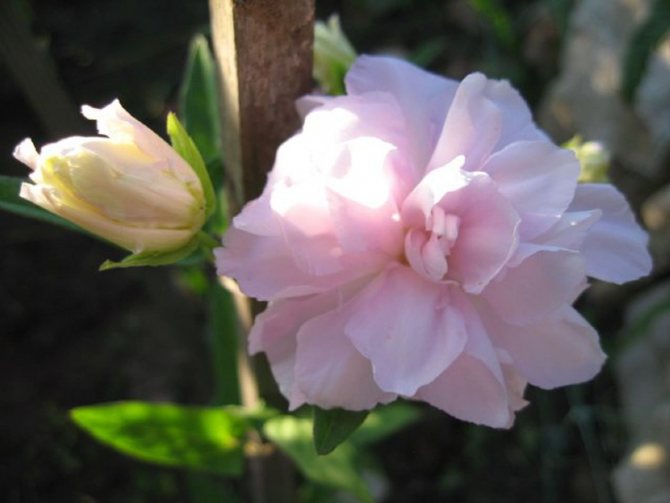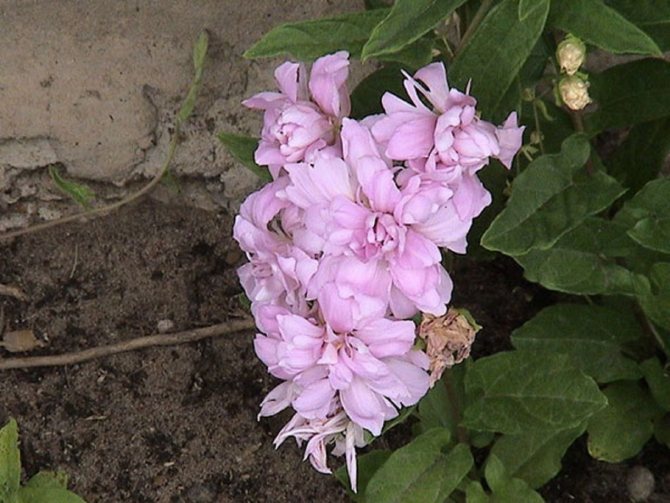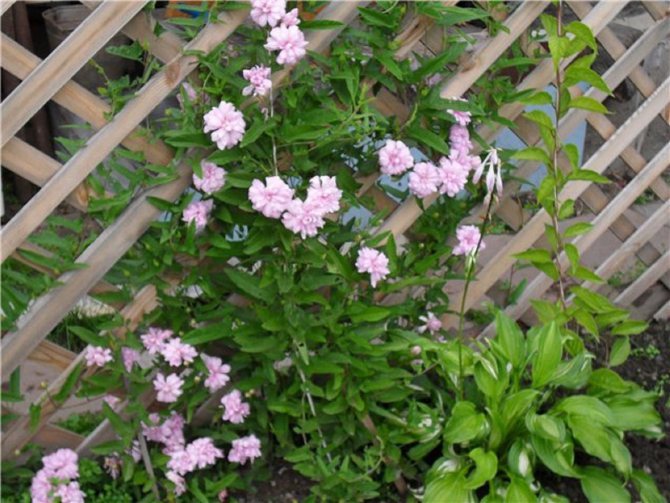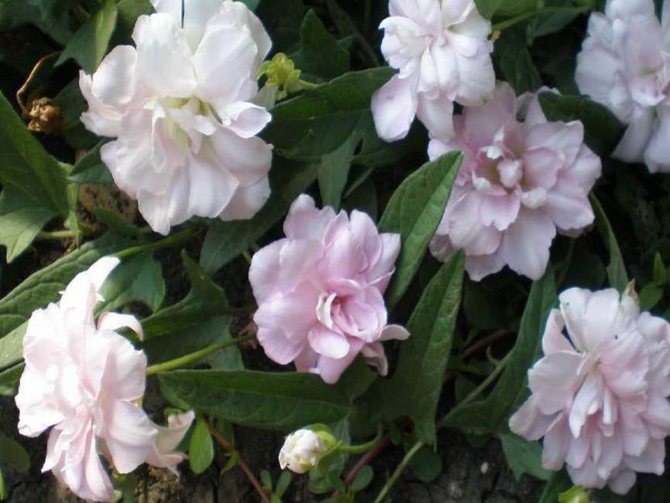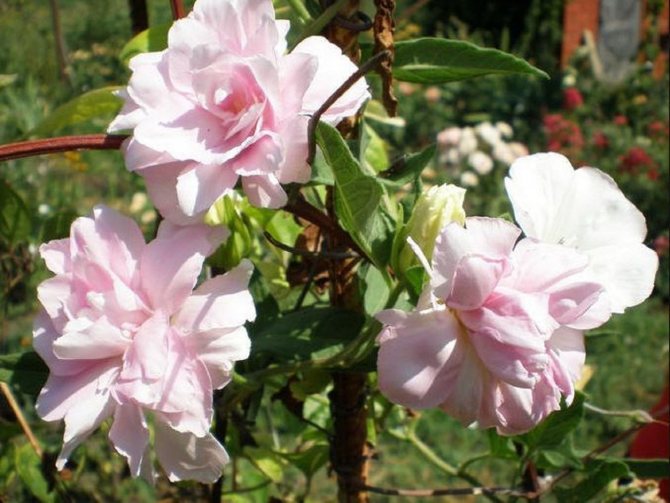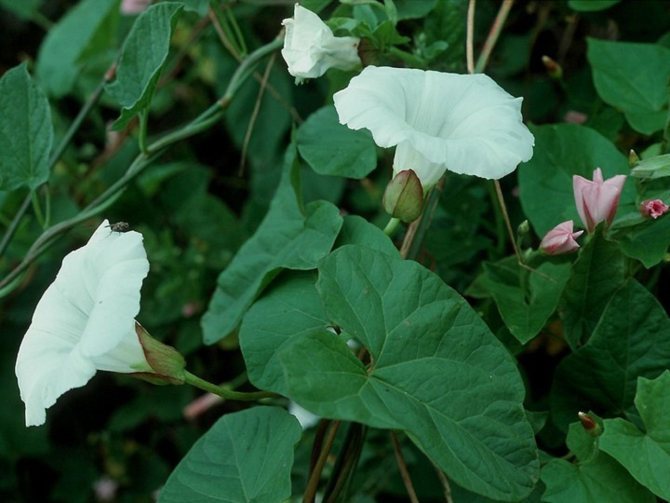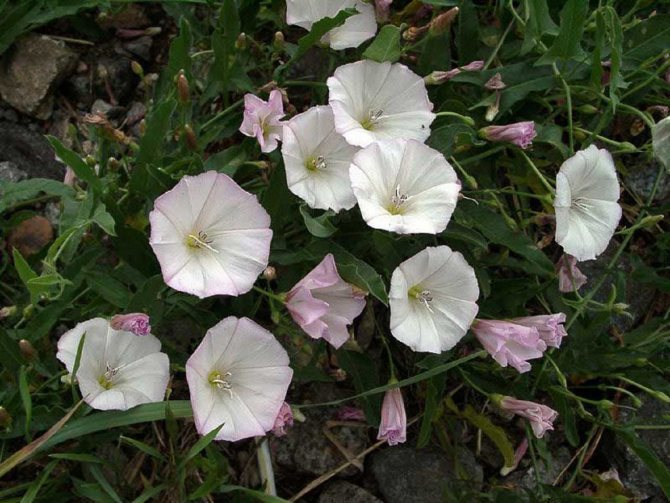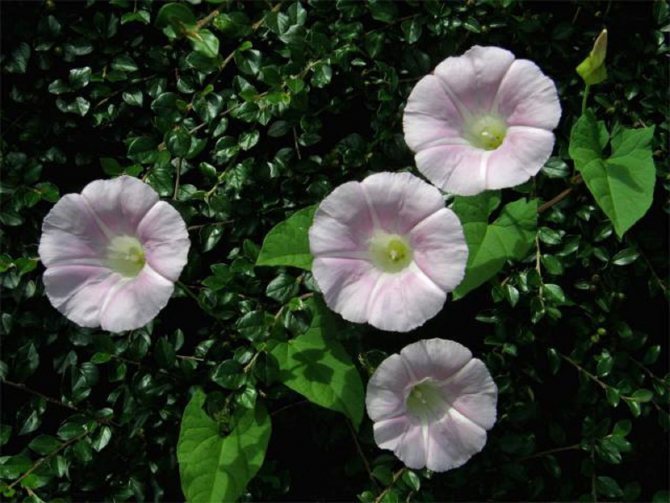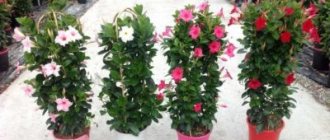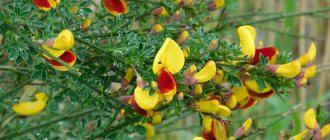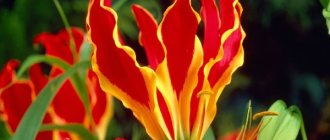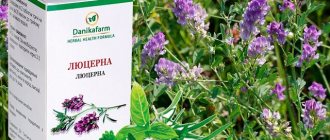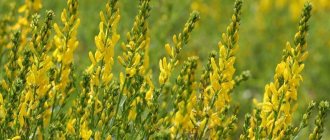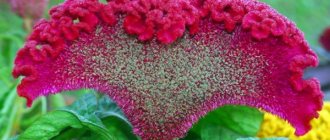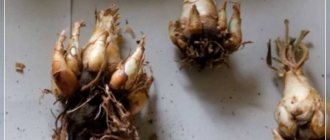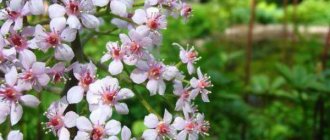Kalistegia is a gentle climbing plant of the Bindweed family. It is also known under the names povoy, bindweed, birch, French rose. The native land of the plant is East Asia (Japan, North China). Sometimes the owners of the plots treat Kalistegiya as a weed that is difficult to get rid of, but it can be turned into a good ally by protecting the rhizome. The fast-growing liana easily braids gazebos, balconies, walls or fences, and delicate flowers bloom over the bright greenery.
Calistegia is a faithful assistant in landscaping and decorating unsightly buildings. Gardeners will love this plant for its ease of care and decorativeness.
Here you will find out:
Terry calistegia: types and varieties for open ground
Only a few varieties of the flower have been cultivated. For cultivation, the types of calistegia described below are more often used.
Fluffy (pubescens)
Found in the wild in China. Liana with long shoots that reach 4 m. Leaves are leathery, slightly elongated. The flowers are pink-white, the core is dark. The most popular cultivar of the species is Flore plena, with delicate pink flowers that look like pompons. The plant begins to bloom in the middle of summer.
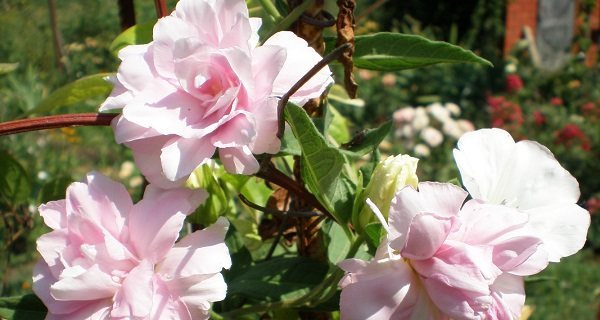
Hairy
A perennial plant native to the Far East. Prefers to grow on rocky slopes, meadows, like a weed. It has stems up to 80 cm long, with elongated lanceolate leaves. The roots are long, cordlike. The flowers are pink, 4-6 cm in diameter, with a corolla formed by 5 fused petals.
The most common plant species
Scientists say there are over two dozen plants, but most of them are wild. They are considered a common weed. And only a few varieties of a beautiful flower are cultivated, they are grown because of their decorative effect.
Calistegia fluffy
Calistegia grows in China. The "fluffy" variety has the longest stems, covered with bright leaves. Flowers can be either simple or double. Their petals have a juicy pink color, and the base of the bud is dark. The most famous species is the captive flora calistegia. It is she who is called "French rose" for its external similarity and delicate smell. The cultivation of calistegia flore plena can be carried out in the garden.
Popular: Oriental notes of your garden with decorative rogers
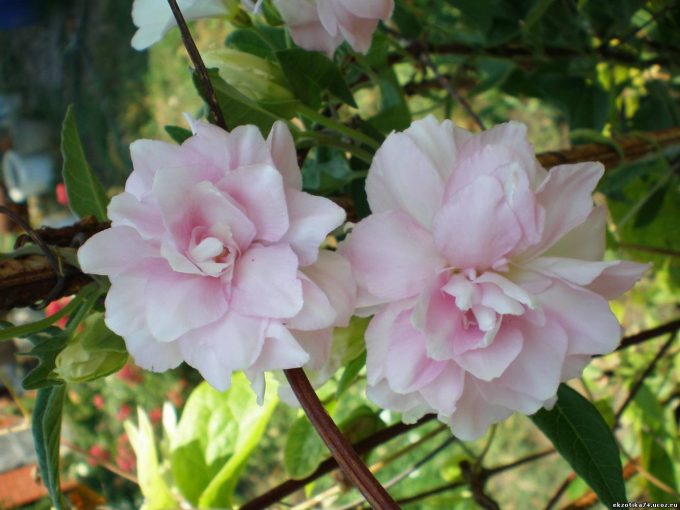

Fence kalistegiya
This type of calistegia is common in many vegetable gardens and orchards. It is considered a weed. In common people it is called "birch" or "bindweed". Growing rapidly, it entangles plants, like a net of its long shoots with flowers that look like bells of pink or lilac color. The flowers are medium-sized and from one to four centimeters.
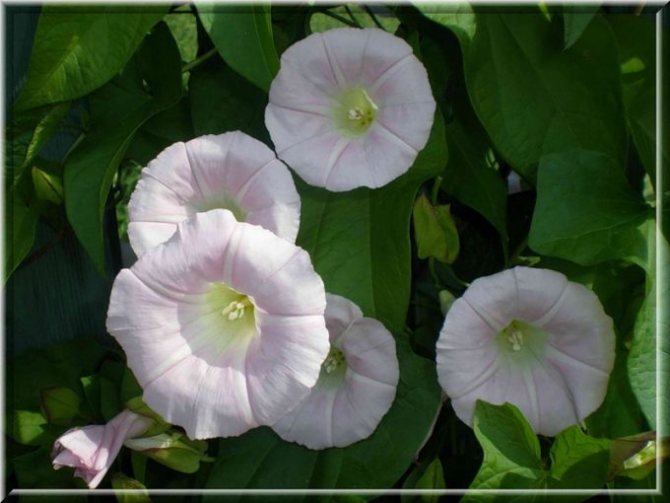

Multiplex
This calistegia variety is distinguished by its frost resistance. Its stems are long and reach 3.5 meters. The foliage of the flower is in the shape of a triangle, and the flowers are terry. The flowers of the kalistegia multiplex have a delicate pink tint and are about ten centimeters in size.
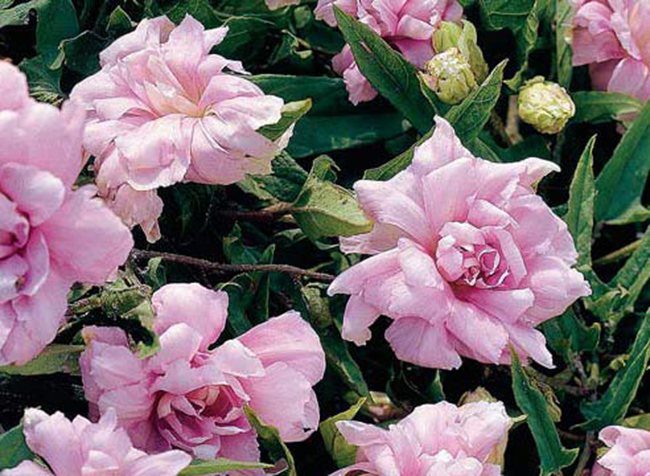

Ivy calistegia
This plant has stems up to 2.5 meters long. You can see small leaves on it. The ivy variety blooms profusely. Flowers can be up to nine centimeters in diameter. Duration of flowering from July to September.
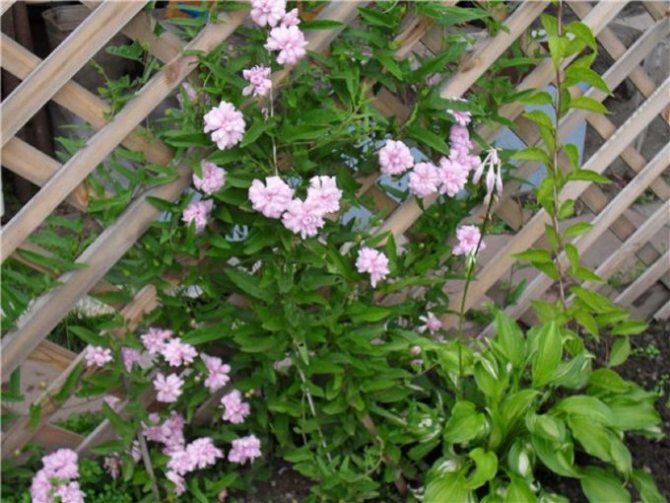

Hairy calistegia
The Kalistegi variety grows in the southern regions of the Far East.It has a developed root system and short stems that reach 80 cm.This variety practically does not twist. The color of the leaves can go yellow. The size of the flowers is from 4 to 6 centimeters. Flower petals have sharp edges. The buds open by the end of summer.
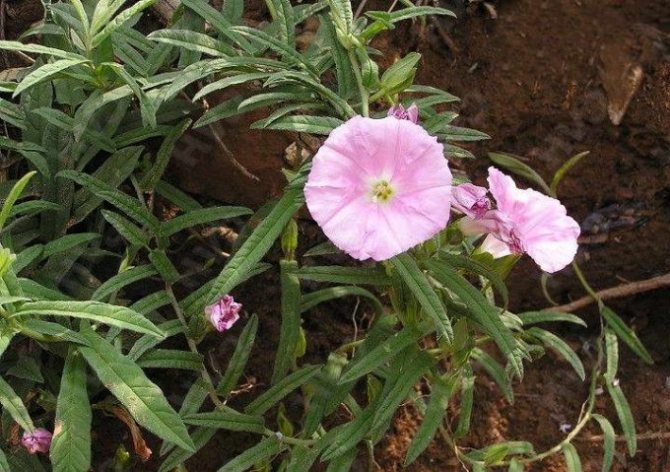

Plant care
If the care of the plant is correct, and the place of the flower bed meets all the requirements, then the calistegia will actively grow and bloom for a long time until winter.
Shine
Terry Kalistegia prefers to grow in a well-lit place. In such conditions, the plant quickly begins to bloom. If it is planted in the shade, then growth slows down, and it blooms, on average, two weeks later. In cases where calistegia is planted under a tree, its crown should not be too thick so that a strong shadow does not fall on the garden bed.
Fertilizer
For an actively growing plant, timely feeding is necessary. In the spring months, it is fed before the beginning of the growing season. The soil is enriched with organic matter, humus is introduced into it. After that, the bed should be loosened. In the summer, once every 14 days, Kalistegia is fertilized with mineral dressings. After the flowers have withered, the birch is pruned, and the ground in this place must be sprinkled with ash.
Suitable soil
With timely feeding, you can plant calistegia in sand or loamy soil. If the soil is fertilized with compost or humus, then you can grow a perennial in one place for up to 15–20 years. This plant does not really like places where groundwater is close.
Popular: Caring for blooming Asiatic lilies on the windowsill and in the garden
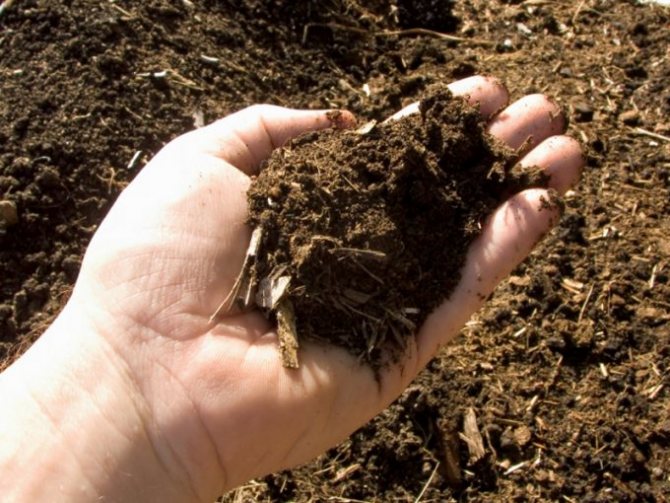

Correct pruning
In summer, prune buds that have already wilted. This procedure provokes the formation of new flowers. In the fall months, the long stems should be cut by 2/3. So, kalistegia will successfully endure frosts, and in the spring months there are more shoots and flowers. Some gardeners even cut the vine to ground level.
Watering mode
In the natural conditions of the growing calistegia, the flora of captivity suffices rain. If the vine grows in the southern region or in places, then you should not additionally water it. This is done only in severe drought conditions. The fact is that the root system is capable of storing moisture. Therefore, if the plant is poured, then this leads to decay of the roots. Watering the calistegia should be additionally done if the heat is strong for a long time and there is no rain.
The main varieties of calistegi
Calystegia belongs to the group of bindweed plants. There are a large number of calistegias that can grow freely in the temperate climatic zone. There are about 25 species of this plant in total. More commonly used varieties include the following:
- pink;
- kalistegia multiplex;
- Daurian with omitted leaves.
This name comes from the Greek language and is translated as "cup" and "cover". The bud has large bracts that form a single calyx
When planting a plant, it is important to remember that it reproduces quite easily:
- the culture forms white rhizomes;
- segments are transplanted in spring when the first shoots appear;
- when carrying out such a planting of a culture in the first year, it will grow up to 1.5 m and begin to bloom with beautiful buds.
There are the most popular varieties of calistegia, which are very often used by gardeners for growing on their site. These include:
- Fluffy calistegia, which appeared in our country from China. The stems are up to four meters long, covered with leathery foliage of bright green color. Large double ringed inflorescences have a pink-white color. This variety is more exposed to low temperatures than others.
- The most popular variety is Flora Plena. The leaves are covered with a characteristic fluff, the inflorescences are large and have petals of an attractive pink hue.
- Kalistegiya Zabornaya, which many call a simple birch. She gives a lot of problems to the gardener. Such a perennial most often grows up to three meters, the foliage is triangular, slightly rounded, simple flowers of a single type, painted white with a pinkish tint. Such crops are growing, as many growers note, at a rapid pace.
- Ivy calistegia. This variety does not differ in the length of the shoots, in comparison with relatives. The total length of the shoots can be up to two meters. Small foliage, located in a certain queue. Flowers are double-type, painted white with a pink tint.
- Hybrid culture. The most popular variety in this case is Multiplex. The total length of the stem reaches three meters, the flowers are large, double, pink in color. The variety is distinguished by its decorative effect, which is why it is widespread in summer cottages.
- Daurian calistegia is an oriental variety with long shoots. There is a noticeable fluff on the foliage, the shape is oblong. The colors are arranged in a single order, painted in bright red.
Types of calistegia
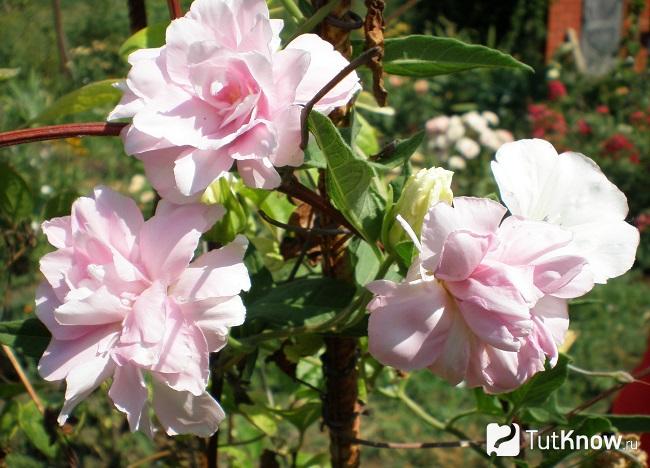

Fluffy Calystegia (Calystegia pubescens).
The homeland of this representative of the flora is China. In the genus, its shoots are considered the longest, their parameters approach the 4-meter mark. Bright green leaves are arranged in succession on the branches. The shape of the leaf plate is elongated, the surface is leathery. This variety, when flowering, can open buds with simple or double flowers. When fully expanded, the corolla varies in diameter in the range of 4–9 cm. The petals are pale pink, but there is a darker color at the base. Among florists, the variety is very popular.
Flore Plena.
Because of the shape of the flower, the plant is often called the French or Siberian rose. The flowers are double-textured; when blooming next to the liana, a faint aroma spreads. Flower buds are formed in leaf axils along the length of the entire shoot. The flowering process begins in late June or early July, but this time directly depends on the place of planting and growing conditions.
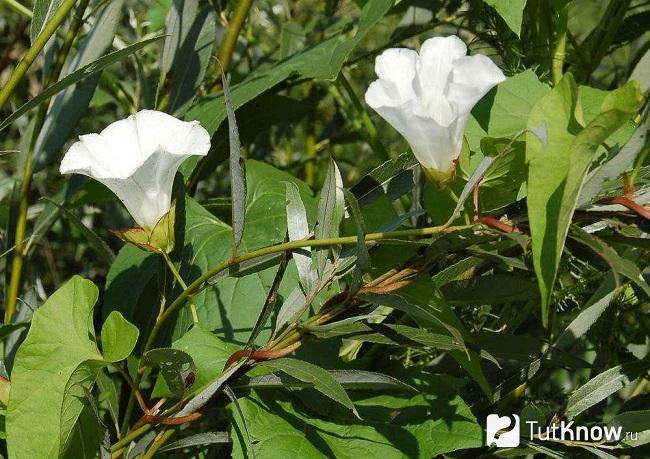

Intake Calystegia (Calystegia sepium).
This species has a very wide geography of distribution. It is considered by many to be a weed that has aggressive properties, invading nearby territories. The rhizome has a strong branching and is buried in the soil by more than a meter. The shoots of the plant are elongated and thin, their length is almost 3 m. Branches alternately cover leaf plates with petioles. In the axils of the leaves, flowers bloom with simple bell-shaped corollas. The color of the petals is snow-white or pale pinkish. A small funnel-shaped flower is formed from the petals. In opening, the diameter of flowers rarely goes beyond 1–4 cm. The flowering process occurs at the beginning of the summer period.
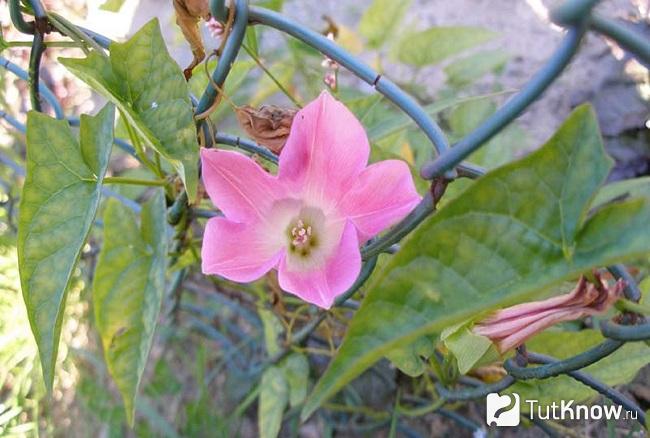

Hairy calystegia (Calystegia Pellita).
The area of natural growth is the southern regions of the Far East and Altai lands. The rhizome has the outline of thick cords that go deep into the soil. Shoots are upright, can grow up to 0.8 m in length. The stems have practically no branching, but in the upper part they are weakly branched. Leaf plates are attached to the shoots by means of petioles. The shape of the leaves is oblong, the color is light green, there is a yellowish tinge. Flowers that originate from the leaf axils have short pedicels. The diameter of an open flower is 4–6 cm. Five petals with splicing at the base form the corolla of the flower. The edge of the petals is pointed. The petals are painted pink or hot pink. The flowering process is observed from June-July.
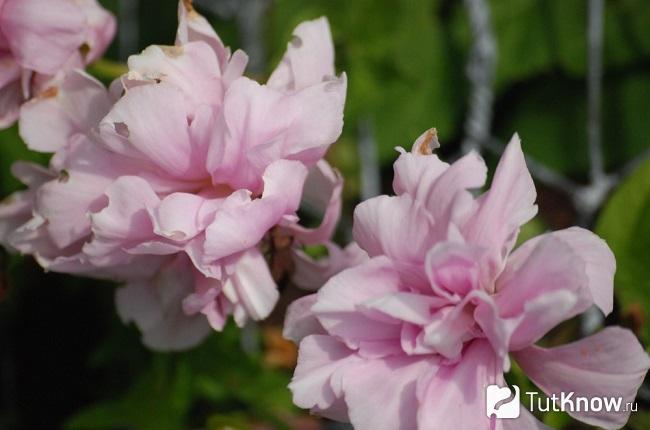

Calistegia multiplex
(Calystegia multiplex).
This variety is frost-resistant.The shoots of the plant can stretch up to indicators of 3–3.5 m. The leaf plates grow alternately and are located very close to each other. The foliage is triangular. When blooming, flowers with a double structure open. The diameter of the flower is almost 10 cm.
Calystegia hederacea
or, as it is also called -
Japanese Calystegia (Calystegia japonica).
It is clear that the native territory is the lands of Japan. In this variety, shoots grow in the form of elastic whips, the length of which varies within 1.5-2.5 m. The foliage grows on the branches alternately, the color is saturated, green. In the axils of the leaves, flower buds form, from which double flowers open. The diameter of the opened flower reaches 9 cm. The flowering process extends from July to September.
Video about growing calistegia:
Photos of calistegia:
Landing in open ground
Calistegia grows rapidly and adapts to different conditions. Therefore, it can be planted immediately in the selected area.
Landing dates
Plant seedlings are planted in early spring. To get them, you need to dig out the rhizome of the bush at the beginning of March, free it from the soil and divide it. The segments should be 5-7 cm long. They are dropped horizontally into peat pots with nutritious soil to a depth of 3-5 cm. After planting, moisten the soil well. After the seedlings reach a height of 5 cm, they must be pinched. Seedlings are planted in open ground in May. Before planting, they are hardened for 1-2 weeks, gradually accustoming them to natural aeration.
Features of planting kalistegiya
Calistegia is propagated by creeping rhizomes, initially they are placed in small greenhouses, and then moved to a permanent place.
For planting and further care, perform the following actions:
- dig a trench deep into the bayonet of a shovel;
- the pit is filled with a mineral complex;
- add ash and humus.
The bindweed is planted in a prepared trench at a distance of 5-25 cm, depending on the variety. After planting the povoy in the soil, to a depth of 45 cm, slate is dug in. This will prevent the flower's root system from overgrowing.
Experienced gardeners plant 2-3 seedlings at once in a bottomless barrel. Then the moisture and fertilizer will be better absorbed, and you will not have to bury the slate to restrict root growth.
Calistegia care
Bindweed cultivation includes control over the following points:
- Lighting. The plant is planted in a well-lit area or in a light partial shade.
- Top dressing. From the first days of May to September, the bindweed needs nutrients. The reason is that the plant blooms for a long time and profusely, feeding is carried out after 8-10 days, minerals are used. To prepare a nutrient solution, a tablespoon of fertilizer is dissolved in a bucket of water and watered with 2 square meters. m. soil. In autumn, ash is sprinkled around the plant, it is also a fertilizer.
- Pruning. During the season, wilted inflorescences are cut off and thin shoots are cut off. When the foliage wilts, remove all dried parts of the flower, leaving a short stump.
- The soil. The soil is selected loose, with sand and clay, should be fertile.
- Watering. The plant is moistened in dry periods of time, they do it abundantly, but without allowing moisture stagnation. Bindweed roots are able to extract moisture from the soil.
Planting and breeding
The flower should not be planted in seed because most varieties are hybrid. Hybrids are unable to inherit maternal characteristics. Calistegia should be propagated using root layers. For this, the rhizome of the flower is dug up, and the fungicide is treated. Cut areas should be treated with charcoal.
After that, the roots are planted at intervals of 0.2 meters. They are buried in the ground by no more than five centimeters. You can keep them in a container with sand or peat until warmth.If young flowers are planted in the autumn months, then the soil is covered with foliage or sawdust. The vine blooms in the first season.
Popular: Three Ways to Grow Blooming Bobo Hydrangea Paniculata
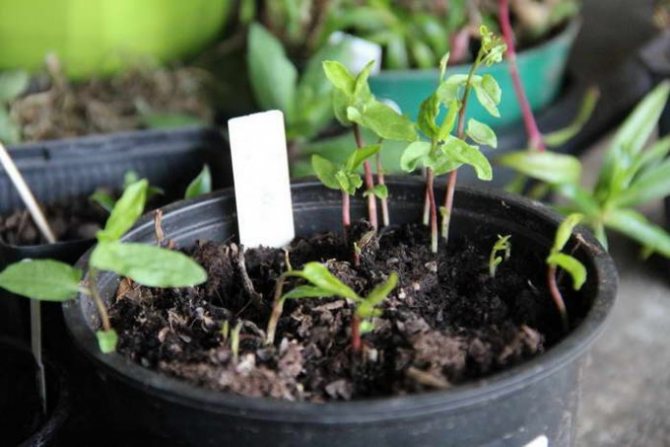

Reproduction is possible with cuttings. From the mother plant calistegia, you need to cut off the stems with buds. After that, it is necessary to remove almost all leaves from the shoot, leaving a maximum of three leaves at the top. The resulting shoot should be placed in water with an added biostimulant. After the roots have grown on the layer, it is moved into the ground.
Outdoor care
Although kalistegia is absolutely unpretentious in comparison with other garden flowers, it must be provided with comfortable conditions for abundant flowering and preservation of its decorative appearance.
Watering
As a rule, natural precipitation is quite enough for the Siberian rose. But if the summer is very dry, you can periodically moisturize the plant. The main thing is not to flood it too much. Stagnant moisture can lead to decay of the root system.
Top dressing and fertilization
Calistegia can be fertilized only during the growing season. Before the start of active growth, in the spring, deciduous and cow humus is introduced. From May to September every 2 weeks the liana is fed with complex formulations. Before wintering, it is recommended to additionally mulch the soil with wood ash.
Bloom
It blooms again in the first year of planting. The buds appear from the leaf axils. Flowering begins in July and can last until the first frost. The better the lighting, the more luxuriant the plant will bloom. The flowers can be white, pink, lilac, depending on the species, with a diameter of 2-9 cm. It is advisable to remove dried inflorescences every week so that they do not spoil the appearance of the plant.
Pruning
Shoots die in autumn. Therefore, it is logical to prune after the onset of frost. Sanitary pruning is carried out in the spring of kalistegi. Weak young shoots are removed. You also need to regularly remove the root shoots in order to contain the intensive growth of the vines.
Transfer
Calistegia does not need obligatory transplants. This procedure is carried out only at the request of the gardener to change the location of the flower. It is better to do this in the fall. With a summer transplant, the plant may die. Dig a hole of sufficient depth. Fertilize it and place the dug bush there. Sprinkle with soil and water.
How to breed calistegia?
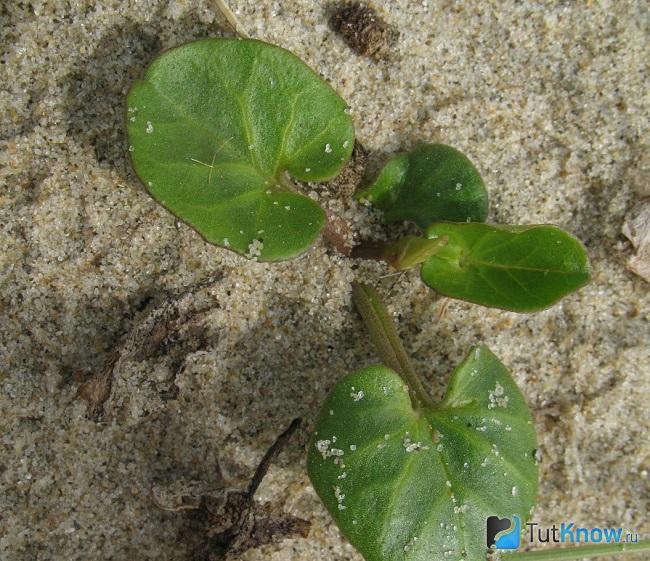

To get a new French rose plant, they are engaged in sowing seeds or planting parts of the rhizome. For cultivated varieties, the vegetative propagation method is suitable.
For example, Calystegia pubescens reproduces only vegetatively. For planting, spring time is selected (most often May), but they are often propagated again in autumn. When choosing a cut, you need to focus on its stems, which were formed during the growing season. It is because of this that the autumn planting is easier, since the grown branches act as a good guide. After planting in autumn days, the plants will need to organize a shelter so that they do not die from frost during a winter with little snow. Next year, such measures will no longer be needed.
The soil must be carefully shaved off the root system of the mother vine and a horizontal shoot must be separated from the rhizome, on which there are a sufficient number of vertically growing shoots. The landing site must be prepared in advance (dig up and fertilize). The cut is cut off with a sharpened shovel, the cut is carefully sprinkled with crushed charcoal. A hole is dug, and a French rose divider is installed in it. In the first year, the stems will grow up to half a meter, and during the next growing season they will reach a length of about 3 m.
You can dig up parts of the calistegia in the fall and plant them in boxes filled with wet river sand, so you can keep the plant until spring. With this maintenance, the substrate should always be evenly moistened, but not flooded. In the place where French rose cuttings will be stored, it is recommended to maintain a temperature of about 10-15 degrees. In late winter or early March, part of the vine is removed and divided into pieces with buds. The groove has the ability to quickly recover, even a small part of the rhizome releases root shoots.
Each division should be 5–7 cm long. The slices are sprinkled with coal powder and planted in prepared pots (seedling boxes) with peat-sandy soil to a depth of about 5 cm. After planting, watering is carried out. After the shoots of the French rose have reached 5 cm, they need to be pinched to stimulate branching. With the arrival of May, when the soil warms up well, calistegia seedlings can be planted in open ground.
Vine seeds in our latitudes form very rarely, therefore this method is used only by breeders to develop new varieties.
How to properly care for a plant
Loose garden soil with a high nutrient content is suitable for growing the plant. Kalistegia is afraid of excessively wet soil, therefore, there should be no nearby groundwater on the site. The obvious advantage of calistegia is the ability to bloom already in the initial year of planting.
Care Tips:
It is fundamentally important that sufficient ventilation takes place on the planted area, and the earth perfectly passes oxygen. Watering should be moderate
Breeding procedure
Terry kalistegia forms many root processes during growth. To move the plant to a new location, you just need to dig up a young shoot and plant it in the required place... During transplantation, it is important to water the young crop. There are no special recommendations on the method of plant propagation. It is allowed to transplant in any season, from spring to autumn. But when planting in late autumn, it is important to ensure that young shoots are not affected by low temperatures.
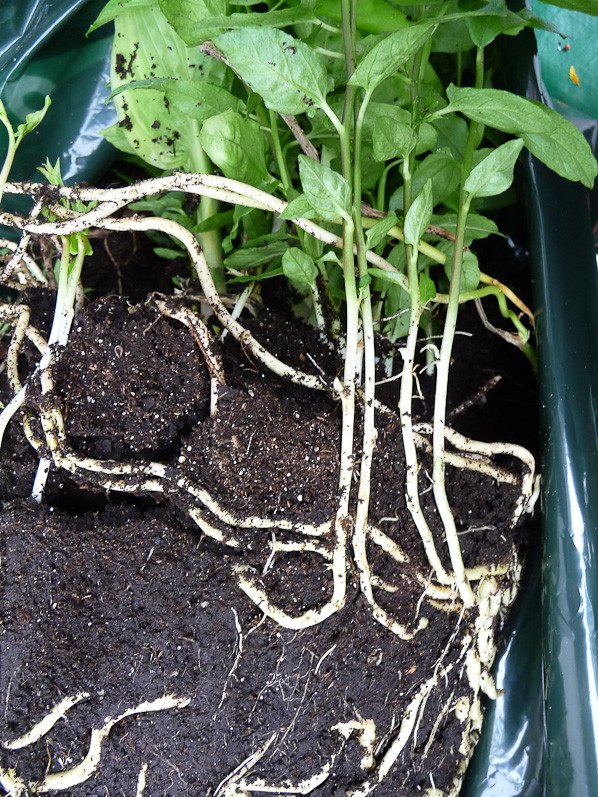

Kalistegia tolerates winter well, so there is absolutely no need to create additional protection for it, but before winter it is important to prune the shrub. During the cold weather, the plants were not noted by experts.
Despite the presence of some shortcomings in the cultivation of calistegia, which, if desired, can be dealt with very quickly, this plant continues to be planted in summer cottages. Gardeners love this culture for its unpretentiousness, quick adaptation to the growing place and great height, which is why it perfectly decorates absolutely any support and structure. Also, the culture is considered unpretentious and does not require special care.
It is important to remember that absolutely all plants require proper care and attention from the gardener. Calistegia will be no exception. Only with this approach to growing a plant, as a result, you can get a truly healthy and strong culture that will help decorate any flower bed and garden.
Protection from pests and diseases
Pova is very resistant to disease. But with regular waterlogging of the soil due to abundant watering or frequent rains, it can become a victim of fungal infections: powdery mildew, root rot. If a problem is identified, it is necessary to immediately stop watering, remove damaged leaves and shoots, and treat the flower with a fungicide.
In dry air, spider mites can settle on the calistegia. It can be destroyed with insecticides (Aktara, Fitoverm, Karbofos). Although the culture is poisonous, it is sometimes attacked by snails and slugs. They eat leaves and flowers, making the plant unattractive. It is recommended to remove these pests manually.To prevent their reappearance, crushed eggshells can be scattered around the bush.
Fight against possible diseases and pests when growing calistegia
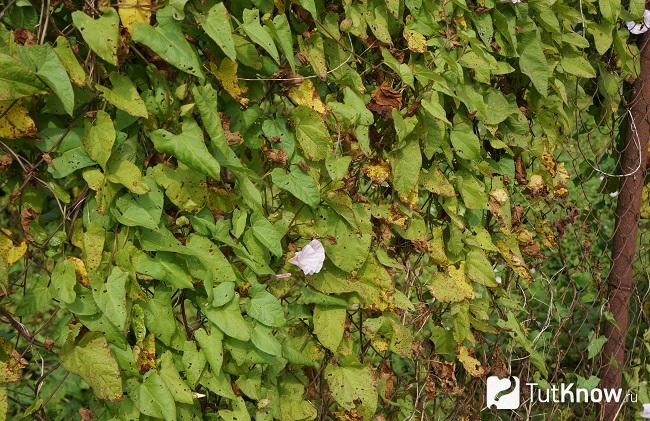

If the summer is cold and rainy, or the irrigation regime is violated and the soil does not have time to dry out, the new one can be affected by fungal diseases (powdery mildew and various rot). Also, the appearance of these problems is facilitated by the thickening of the plantings, the presence of weeds next to the Siberian rose bush, the use of contaminated garden tools, and uncleared fallen leaves.
At the same time, a whitish coating forms on the leaves and stems, which resembles a frozen lime solution. This layer does not allow air and sunlight to reach the surface of the plant, and then the process of photosynthesis slows down, and soon stops altogether. Liana begins to turn yellow and then die off. After a thin web becomes visible on the surface of the leaves, the plant dies. To eliminate the problem, it is recommended to spray with an iodine solution or treat with fungicidal preparations, which are in large quantities in specialized stores (for example, Fitosporin).
If yellowed or brownish areas are visible on the leaves, the stems and foliage have become soft, then perhaps these are symptoms of the onset of putrefactive processes. All affected parts of the calistegia must be removed and treated with fungicides. Often, only the removal of the affected specimens with the transplantation of healthy bushes to a new place helps. It is also necessary to even out the watering regime after it becomes clear that the disease has been stopped.
Pests in garden cultivation for the French rose can be snails and slugs, which love to feast on foliage and buds. These gastropods gnaw holes in leaf blades and in unopened flowers, depriving the plant of its attractiveness. To combat them, processing by such means as Confidor, Commander or Meta-Thunder is required.
What is the Kalistegia flower
Kalistega is a perennial flower with a highly branched root system. If you do not set fences around the perimeter of the flower bed, young shoots can appear even one and a half meters from the mother plant (Figure 1).


Figure 1. Calistegia is also called the "Siberian rose" for its amazing hardiness
The culture has long, curly stems that can grow up to 4 meters in length. The bark is brown. Bright green leaves are attached to the stems on long stalks. This crop has a very long flowering, which is why it is often grown on balconies.
Difficulties in growing a flower
Despite the large number of advantages, such a plant also has disadvantages, which, as a result, lead to problems when growing. The most common difficulty is the overgrowth of rhizomes. If you do not remove part of the root system with young shoots from the soil in time, then it will very quickly become a serious weed, which will subsequently be quite difficult to fight.
Features of growing gloxinia at home and caring for it
To prevent this from happening, it is important to determine the main border of the plant rhizomes. To do this, a sheet of metal is buried in the ground, which will prevent the spread of rhizomes and will become a certain boundary. This design will be a kind of large pot, but the plant will not have any difficulties with the development of free space.
So that the plant has as few parasites as possible, it is best to treat it with special pesticides.
Reproduction
Calistegia reproduces at home only vegetatively. The best way to do this is by using root suckers. They need to be carefully dug up and transplanted in a previously prepared area. The procedure can be carried out throughout the growing season.
Sometimes vertical cuttings are taken for propagation. They are placed for some time in a growth stimulant solution (Kornevin or Epin). Then they are planted in a peat-sand mixture for rooting, covered with a jar to create a greenhouse effect. After the roots appear, they can be planted on the site.
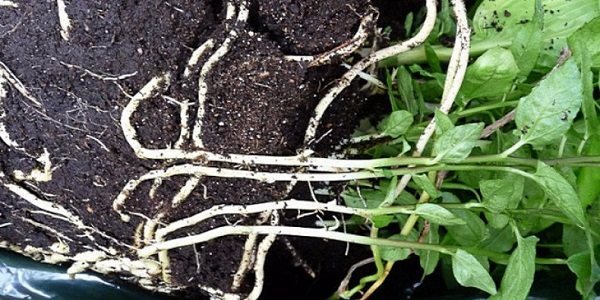

Choosing a landing site
Illumination
Well lit by sunlight, the area contributes to a luxurious abundant flowering. The plant is tolerant of shading, but it will begin to bloom 15-20 days later.
The soil
Liana can grow on any soil: loamy, peaty, deciduous. Loose, light, moderately fertile soils are preferred. Under such conditions, it feels comfortable for more than a dozen years. Over time, it may be necessary to replace the top layer of the soil.
Ground water
Stagnation of moisture in the roots is detrimental to the plant - do not plant in lowlands, in flooded areas. Undesirable close occurrence of groundwater: you can build a high bed.
In one place, the plant grows well for 10-30 years. The main task is initially the correct choice of a site for growing, so that the plant will delight with its beauty for many years. Remember that terry calistegia is aggressive in growth and can "crush" any flowers. It is better not to place flower beds or front gardens nearby - a liana with beautiful inflorescences will become a full-fledged solo decoration of the area.
Planting a French rose
If you do not have a calistegy yet, then plant it using the following tips.
The soil for planting this loach should be moderately moist, loose. It is advisable to take sand with turf and humus in a ratio of 1: 2: 2. Sand can be replaced with ash or dolomite flour. Before planting, the soil is dug up and fed with complex mineral fertilizer (2 tablespoons per 1 square meter) and ash (2-3 glasses per 1 square meter).
Take parts of the rhizome and place them at a depth of 15-20 centimeters. The soil must be constantly moistened.
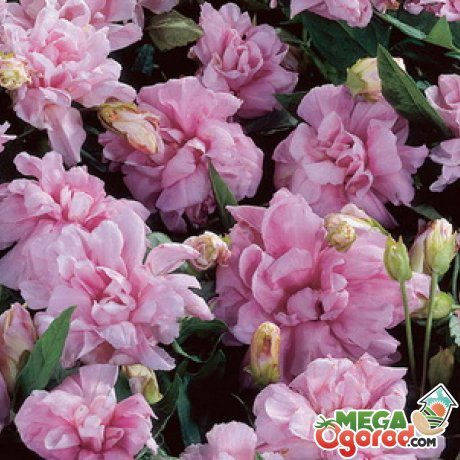

It is necessary to plant Kalistegiya in a well-lit place, but in partial shade it also grows well. Better to plant Kalistegiya in the spring. If you planted a plant in the fall, then you should definitely cover it for the winter. To do this, you can take sphagnum moss or other covering material.
When the calistegia grows up, it is necessary to pull the ropes or netting so that the plant can weave.
Terry calistegia in landscape design
Since povoy is a liana, it is ideal for landscaping vertical surfaces. They can decorate mesh gazebos, terraces, arches. Calistegia can be grown as a hedge. With the help of this plant, you can visually increase the area of the site if you make an opening from several arches along which it will trail. Bindweed is a bad neighbor for other plants in the flower bed. It is better to plant it separately. It grows quickly, has a strong root system and can simply drown out the growth of other crops.
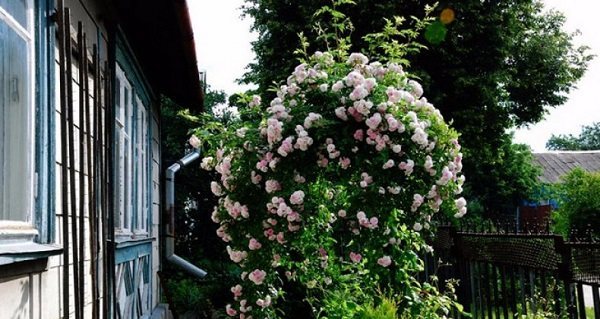

Terry Kalistegia is a blooming liana that can decorate any landscape. It is ideal for unsightly areas, walls and fences. Unlike many other decorative flowers, calistegia requires little or no attention. But for a long and abundant flowering, it must be provided with a sufficient amount of light, moisture, nutrients.
Next is a video, from which you can find out more useful information for flower growers about the features of growing terry Kalistegia and the use of decorative liana for effective landscaping of the site:
Using calistegia
Kalistegia is perfect for vertical gardening. If there are gazebos, arches, outbuildings in the garden, the plant will quickly hide their contours under a solid green carpet. A simple chain-link will be a good basis for a future hedge.
The plexus of several shoots resembles a garland covered with a cap of delicate flowers. It is suitable not only for everyday decoration, but also for a solemn event. It is enough to plant the rhizome in the right place in a few months and the dense thickets will take the required shape.
It is undesirable to plant calistegia in the front garden or on a flower bed where other plants grow. She behaves aggressively in the neighborhood. It is better to highlight a liana corner near a tree with a sparse crown or an area in an open area.
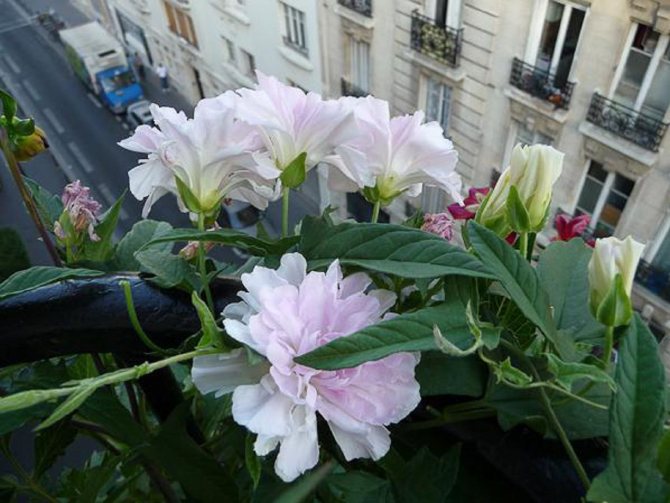

You can plant the calistegia in boxes and display them on the balcony or veranda. She will decorate the pillars and windowsill. At night or in bad weather, the flowers close, and in the bright sun they open again. Because of this feature, calistegia is not suitable for the formation of bouquets.
Post Views: 1
Features of plant transplant
If the culture begins to bloom poorly in the second or third year after planting in the soil, then you can transplant the plant. It is carried out as follows: the bucket is filled with earth, and then all the contents are shaken out of it.
The condition of the rhizomes can deteriorate greatly and lead to flowering disorders. Roots can spread in breadth in search of nutrients, which leads to a decrease in headspace. In this case, food will not be enough for the normal flowering of the culture.
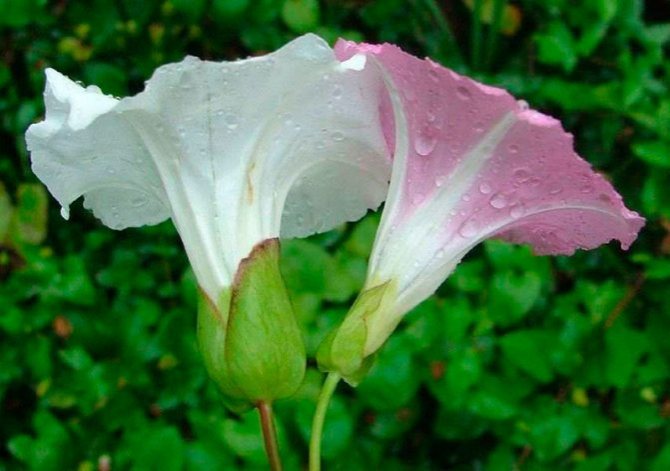

It is best to transplant and plant a plant in spring. It is allowed to transplant a couple more rhizomes into the same bucket or a separate container, and replace the soil mixture with a new one. In a new place and with an established support, the culture, as a rule, blooms better and with larger flowers.
In order for the stems to start twisting separately, you can pull several nylon ropes and tie them to the main support made of wood. In this case, each stem will have its own separate rope.
The higher the support is, the higher the plant will rise (it can grow up to four meters in height). During flowering, one double-type flower is formed in the leaf axils (each such flower is in a separate axil) and continues to bloom for only a few days - this is considered the main disadvantage of the plant.
With the onset of cold weather, the flowering process of the plant will last much longer than under the condition of high temperatures outside. In a sunny area, the flowering process begins at the end of June, and in a shaded area - after a month. This process continues until the onset of the first frost.
Planting principle
Many gardeners choose fluffy calistegia for planting., which belongs to the multiplex. Planting and caring for the multiplex calistegia is not particularly difficult. The main features of the plant are climbing shoots, perennial growth, a height that can range from 3 to 3.5 meters, and resistance to low temperatures.
In autumn, the aboveground part of the culture dies off, so in autumn it is better to cut the plant, leaving a short stump in its place. In the middle lane, the culture departs from dormancy only at the end of May, when the nighttime subzero temperatures completely recede.
It is this feature of the flower that saves it from freezing. After, subject to the creation of all favorable conditions for planting the calistegia and caring for it, the flower begins to develop at an accelerated pace, by mid-June the total height can reach up to 1.5 meters, while a large number of flowers bloom on it.
The flowering of such a plant lasts for a long time - from the end of June to the onset of October. Terry flowers are large (up to 9 centimeters in diameter), have an iridescent pink color and cover the culture from top to bottom. The main disadvantage of the flower is the lack of aroma.
If we talk about planting calistegia in open ground, then the culture is undemanding to the soil mixture.The plant adapts to growing in almost any climatic zone.
A sunny and shaded place is acceptable to the culture, the negative effect of parasites and diseases is not scary for calistegia. Maintenance includes regular loosening and fertilization of minerals and mullein.
Bindweed in assortment
So, the family of bindweed (Convolvulaceae), we, the inhabitants of Central Russia, know only two of its representatives. Meanwhile, this family is not even very small, but very, very solid - 50 genera and 1500 species. But the bindweed prefer the tropics. It is in the tropics that the largest genus of bindweed, Ipomoea, flourishes, including about 500 species. The genus bindweed (Covolvulus) is also not small - 250 species. Bindweed, by the way, are more or less evenly represented on all continents except Antarctica.
Curious notes about calistegia
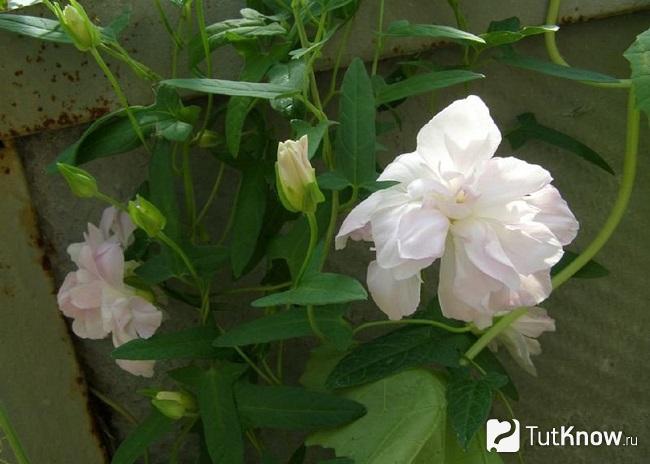

Pova is not only an ornamental plant, it has long been used by folk healers for treatment, but you should not forget that it is poisonous.
Important!!!
Calistegia should be planted in places where small children will not have access to it, as the flowers can provoke poisoning if they are eaten.
Of the properties that are attributed to new, they distinguish: laxative, sedative and hypnotic, as well as the ability to heal wounds. Calistegia tincture is used as an antiparasitic drug. If the patient suffers from fever, cancer or various types of pain, folk healers recommend using decoctions from Siberian rose leaf plates. If the leaves are crushed and applied to the skin affected by furunculosis, it will be cleansed.
Fertilization
For the American Calistegy, you don't need to draw up a special care scheme. In spring, to ensure faster growth, it is important to fertilize it with a mineral composition. Top dressing of this type is best used regularly, once every ten days.
Before flowering, it is better to feed the culture with a mullein solution, and then repeat the procedure, but already during flowering. Watering the flower is carried out only when necessary. In the limited space of barrels and buckets, moisture continues to persist for a long time, so too frequent watering is also not necessary.
The most dangerous parasites for this plant are slugs and snails, which can significantly affect the decorative characteristics of the crop. Pests make ugly holes on the leaves, and they eat the flowers altogether. It is best to plant such a culture in sunny places. To combat harmful insects, it is allowed to use Konfidor and Commander for spraying.
If we talk about diseases, then calistegia is most often affected by powdery mildew and rot. Powdery mildew most often manifests itself on the leaves when the weather is cold or humid for a long time in summer. To prevent disease, it is important to use fungicides, for example, Fitosporin or Topaz solution.
Botanical description of the plant
Kalistegia belongs to the bindweed family. The homeland of the flower is East Asia. The plant can be found in Japan and northern China. It grows very quickly, the stems instantly stretch out in length. A distinctive feature of the French rose is a lush, mesmerizing bloom. The flowers are double, pearl pink. They completely cover the whole plant and shimmer amazingly in the sun. They resemble roses or peonies in appearance. They look very elegant due to their size. Each flower is massive, about 10 cm in diameter.
The plant is stable and unpretentious. However, he needs a lot of sun and light. It grows well in any soil, rarely exposed to diseases and parasites.
Calistegia multiplex competes with popular clematis in terms of external data. Other representatives of the bindweed genus cannot boast of such a gorgeous flowering.
Calistegia belongs to the plant genus of the Bindweed family. It is presented in the form of a herbaceous liana-shaped perennial with a branched creeping rhizome and curly stems reaching up to 4 m in length. The leaves are in the shape of a triangle, pointed at the end, alternately held on the stems with the help of long petioles.
The flowers are single, white or pink, 2-9 cm long. They delight with flowering from June or July until the coldest days. After that, the fruit is formed in the form of a dry capsule, which consists of 4 valves.

